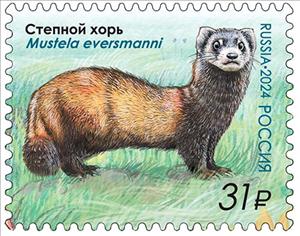Stamp: Steppe Polecat (Mustela eversmanii) (Russia 2024)
Steppe Polecat (Mustela eversmanii) (Russia 2024)
08 August (Russia ) within release Fauna of Russia : The Askania Nova Biosphere (2024) goes into circulation Stamp Steppe Polecat (Mustela eversmanii) face value 31 Russian ruble
| Stamp Steppe Polecat (Mustela eversmanii) in catalogues | |
|---|---|
| Colnect codes: | Col: RU 2024.08.08-01b |
Stamp is horizontal format.
stamp from se-tenant block of fourAlso in the issue Fauna of Russia : The Askania Nova Biosphere (2024):
- Stamp - Bustard (Otis tarda) face value 31;
- Stamp - Eastern Steppe Viper (Vipera renardi) face value 31;
- Se-tenant - Fauna of Russia : The Askania Nova Biosphere face value 4*31;
- Mini Sheet - Fauna of Russia : The Askania Nova Biosphere face value 8*31;
- Stamp - Lesser Kestrel (Falco naumanni) face value 31;
- Stamp - Steppe Polecat (Mustela eversmanii) face value 31;
Stamp Steppe Polecat (Mustela eversmanii) it reflects the thematic directions:
Animals are multicellular, eukaryotic organisms of the kingdom Animalia (also called Metazoa). All animals are motile, meaning they can move spontaneously and independently, at some point in their lives. Their body plan eventually becomes fixed as they develop, although some undergo a process of metamorphosis later on in their lives. All animals are heterotrophs: they must ingest other organisms or their products for sustenance.
Mammals are any vertebrates within the class Mammalia (/məˈmeɪli.ə/ from Latin mamma "breast"), a clade of endothermic amniotes distinguished from reptiles (including birds) by the possession of a neocortex (a region of the brain), hair, three middle ear bones and mammary glands. All female mammals nurse their young with milk, secreted from the mammary glands. Mammals include the largest animals on the planet, the great whales. The basic body type is a terrestrial quadruped, but some mammals are adapted for life at sea, in the air, in trees, underground or on two legs. The largest group of mammals, the placentals, have a placenta, which enables the feeding of the fetus during gestation. Mammals range in size from the 30–40 mm (1.2–1.6 in) bumblebee bat to the 30-meter (98 ft) blue whale. With the exception of the five species of monotreme (egg-laying mammals), all modern mammals give birth to live young. Most mammals, including the six most species-rich orders, belong to the placental group. The largest orders are the rodents, bats and Soricomorpha (shrews and allies). The next three biggest orders, depending on the biological classification scheme used, are the Primates (apes and monkeys), the Cetartiodactyla (whales and even-toed ungulates), and the Carnivora (cats, dogs, seals, and allies).
Polecat is a common name for several mustelid species in the order Carnivora and subfamilies Ictonychinae and Mustelinae. Polecats do not form a single taxonomic rank (i.e. clade). The name is applied to several species with broad similarities to European polecats, such as having a dark mask-like marking across the face.


